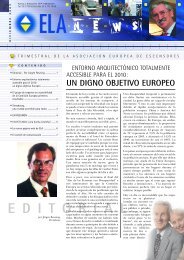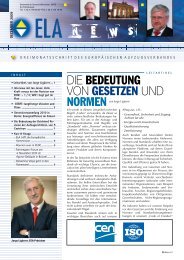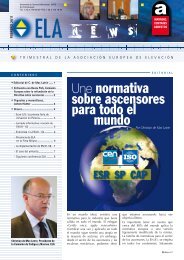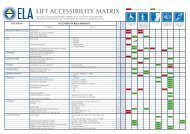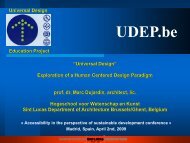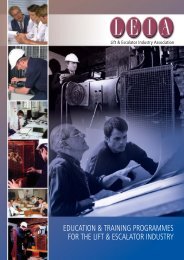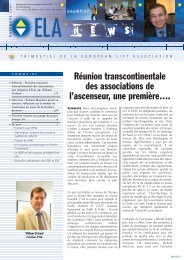WP6-Brochure-E4 brochure - ELA European Lift Association.
WP6-Brochure-E4 brochure - ELA European Lift Association.
WP6-Brochure-E4 brochure - ELA European Lift Association.
Create successful ePaper yourself
Turn your PDF publications into a flip-book with our unique Google optimized e-Paper software.
14 Check usage and optimisation of counter‐balancing<br />
A counter‐balance reduces the load the lift drive system has to move when the lift is running.<br />
This allows the use of smaller motors and less energy is required to operate the system.<br />
Often a counter‐balance has the same mass as a lift car plus half of the nominal load.<br />
Therefore, it requires less energy when the lift is carrying half of the payload. In practice, lifts<br />
often travel empty to their destination floors, or they transport only a small number of<br />
passengers, thus the actual average load is below 50% 6 . Adjusting the mass of the counterweight<br />
can thus be an option to reduce the average motor load and to reduce energy<br />
requirements.<br />
Recommendation: consider using a counter‐weight to reduce the load the drive system has to<br />
lift and optimise it in accordance with the actual usage requirements.<br />
Relevance: especially relevant for new installations but also for (larger) retrofits.<br />
15 Reducing the mass of the car<br />
In systems without a counter‐weight, the motor has to lift both the weight of the cabin as well<br />
as the additional payload. Therefore, the reduction in cabin weight, by using for example light<br />
weight materials, can increase energy efficiency, provided that both stability and safety remain<br />
unaffected. In addition, a reduced mass can decrease energy demand for acceleration and<br />
deceleration, also in systems with a counter‐weight.<br />
Recommendation: check benefits of using a car with reduced mass.<br />
Relevance: especially relevant for new installations and (larger) retrofits that are often used<br />
and that do not have a counter‐weight.<br />
Table 7‐6. Energy efficiency: <strong>Lift</strong> auxiliary equipment<br />
Design of ancillary lift equipment<br />
16 Use energy‐efficient lighting & appropriate surface material<br />
Lighting can be one of the most important energy consumers in a lift, especially when it is<br />
burning 24 hours a day. Reducing the required lighting power is thus an important option to<br />
increase energy efficiency. Modern lighting technology like compact fluorescent lamps or LED<br />
technology can reduce energy consumption (see Chapter 3).<br />
Avoiding dark surface materials and textures in the car interior can also contribute to reducing<br />
the energy consumption required by lighting.<br />
Recommendation: the most energy‐efficient solution for permanently running lighting is to use<br />
LED lighting. Using energy‐efficient lighting and switching it off is a complementary solution<br />
(see also item 22).<br />
Relevance: very relevant for new installations and also for minor retrofits. A replacement of<br />
the lighting equipment can also be easily accomplished in existing installations. This measure is<br />
estimated to be very cost‐effective.<br />
6<br />
Cf. the assumed load collective used in Nipkow 2005, Brzoza‐Brzezina 2008.<br />
110





